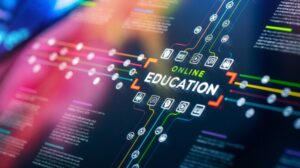Education Loves all Tech
In the 21st century, the symbiotic relationship between education and technology has transformed the landscape of learning. Because the traditional classroom setup has evolved into a dynamic, tech-infused environment, bringing forth a wave of opportunities and challenges. So let’s explore the intricacies of this relationship and how “Education Loves all Tech.”
Importance of Technology in Education
Because education and technology have become inseparable companions, fostering an environment where learning transcends traditional boundaries. So the integration of technology in education opens doors to a myriad of possibilities, redefining the way knowledge is imparted and acquired.
Evolution of Educational Technology
From chalkboards to interactive whiteboards, textbooks to e-books, education technology has come a long way. Because the continuous evolution signifies a commitment to providing students with innovative tools for enhanced learning experiences.
Integration of Tech in Traditional Learning
Smart Classrooms
Smart classrooms leverage digital tools like interactive displays, tablets, and educational apps to create an immersive learning environment. Because students actively engage with content, fostering a deeper understanding of subjects.
Online Learning Platforms
So the rise of online learning platforms has democratized education, making it accessible to learners worldwide. Whether it’s a video lecture or an interactive quiz, online platforms cater to diverse learning styles.
Benefits of Educational Technology
Enhanced Engagement
Technology captivates students’ attention through interactive content, because gamified learning modules, and multimedia presentations, making the learning process more engaging and enjoyable.
Personalized Learning
Adaptive learning systems tailor educational content to individual students’ needs, so allowing them to progress at their own pace. Because this personalized approach enhances comprehension and retention.
Challenges in Implementing Tech in Education
Accessibility Issues
Despite technological advancements, some students face barriers to accessing digital resources. So addressing these accessibility issues ensures that every student can benefit from educational technology.
Digital Divide
The digital divide exacerbates educational inequalities, as not all students have equal access to technology. Because bridging this gap requires concerted efforts from educators, policymakers, and communities.
Future Trends in EdTech
Artificial Intelligence in Education
Artificial Intelligence (AI) is revolutionizing education by providing personalized learning experiences, automating administrative tasks, and offering real-time feedback to students.
Gamification
Gamification introduces elements of games into educational activities, making learning more enjoyable and motivating for students. It enhances collaboration and problem-solving skills.
Case Studies: Successful Tech Integration
Adaptive Learning Systems
Schools and institutions implementing adaptive learning systems report significant improvements in students’ performance, demonstrating the efficacy of personalized learning approaches.
Virtual Reality in Education
Virtual Reality (VR) takes students on immersive educational journeys, from exploring historical landmarks to dissecting virtual organisms. It adds a new dimension to experiential learning.
Impact of Tech on Teacher Roles
Facilitating Learning
Teachers transition from being knowledge disseminators to facilitators, guiding students through interactive and collaborative learning experiences facilitated by technology.
Skill Development
Educators play a pivotal role in developing students’ digital literacy, critical thinking, and problem-solving skills, preparing them for the demands of the digital age.
Addressing Concerns: Privacy and Security
Data Protection Measures
Educational institutions must implement robust data protection measures to safeguard students’ sensitive information and ensure a secure learning environment.
Safe Learning Environments
Creating safe online spaces is crucial for fostering a positive learning experience. Because educators and administrators must prioritize online safety and cyberbullying prevention.
The Role of Social Media in Education
Collaborative Learning
Social media platforms provide avenues for collaborative learning, so enabling students to share ideas, resources, and insights beyond the confines of the classroom.
Networking Opportunities
So educators and students can leverage social media for networking, connecting with peers, industry professionals, and experts to enhance for their learning experiences.
Balancing Screen Time and Physical Activity
Strategies for a Healthy Learning Environment
Balancing screen time with physical activities is essential for students’ overall well-being. So implementing strategies that encourage breaks and movement contribute to a healthy learning environment.
Importance of Breaks
Scheduled breaks not only refresh students but also contribute to better focus and concentration during learning sessions. Because they are crucial for maintaining a healthy balance.
Overcoming Resistance to Tech Adoption
Teacher Training Programs
Comprehensive training programs empower educators to embrace technology confidently, overcoming resistance and ensuring effective integration into the curriculum.
Parental Involvement
Engaging parents in understanding the benefits of educational technology fosters a supportive environment, encouraging collaboration between home and school.
Success Stories: Students’ Perspectives
Improved Learning Experiences
Students report increased enthusiasm for learning when technology is seamlessly integrated into their education. Interactive lessons and multimedia content enhance comprehension and retention.
Skills for the Digital Age
Technologically adept students are better equipped for the challenges of the digital age, acquiring skills that are essential for future success in a technology-driven world.
Navigating the EdTech Marketplace
Choosing Appropriate Tools
Educators must navigate the vast EdTech marketplace to select tools that align with their educational goals. So considering the specific needs of students is crucial for successful implementation.
Budget Considerations
While exploring educational technology options, institutions must balance innovation with budget considerations to ensure sustainable and cost-effective solutions.
Ensuring Inclusivity in Tech-Focused Education
Accessibility Features
EdTech developers should prioritize accessibility features, ensuring that their products are inclusive and cater to the diverse needs of all learners.
Tailoring Education for Diverse Learners
So customizing educational experiences based on individual learning styles and abilities contributes to a more inclusive and equitable education system.
FAQs
- Is educational technology suitable for all age groups?
- Educational technology can be adapted for learners of all ages, from primary school to higher education.
- How can schools address the digital divide among students?
- Because schools can implement initiatives such as providing devices, internet access, and technology training to bridge the digital gap.
- Are there privacy concerns with the use of educational technology?
- Yes , because privacy concerns can arise, but institutions can mitigate them by implementing robust data protection measures.
- How can parents support their children’s engagement with educational technology?
- So Parents can stay informed about the technology used, set screen time limits, and engage in discussions with their children about their online experiences.
- What role does gamification play in educational technology?
- Gamification enhances engagement by incorporating game elements into educational activities, then making learning more enjoyable and motivating.
Conclusion
So as we navigate the ever-evolving landscape of education and technology, because it’s clear that the love affair between the two is here to stay. so embracing the possibilities that technology brings to education allows us to create a future where learning knows no bounds.
Discover More Blogs:



1 thought on “Education Loves all Tech”